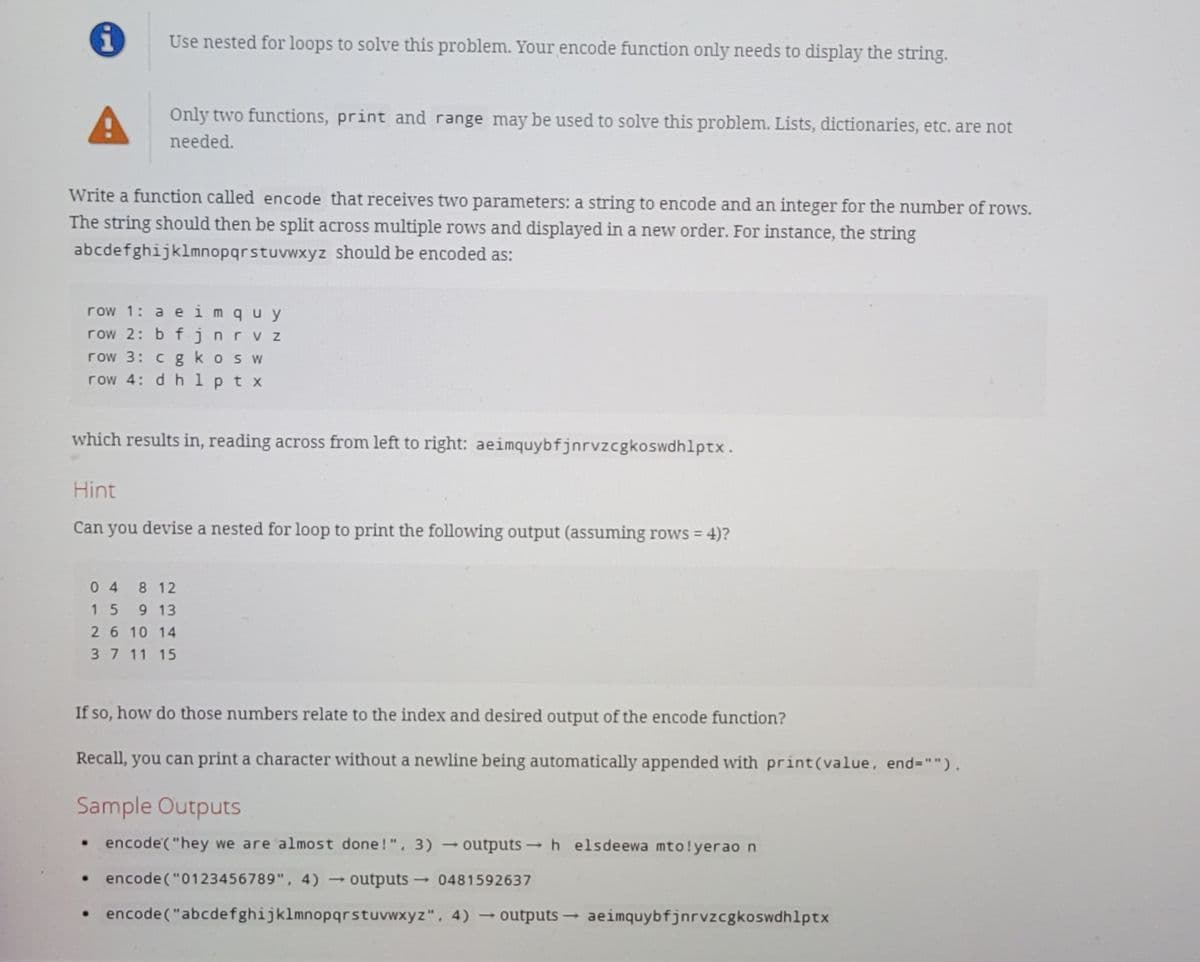Use nested for loops to solve this problem. Your encode function only needs to display the string. A Only two functions, print and range may be used to solve this problem. Lists, dictionaries, etc. are not needed. Write a function called encode that receives two parameters: a string to encode and an integer for the number of rows. The string should then be split across multiple rows and displayed in a new order. For instance, the string abcdefghijklmnopqrstuvwxyz should be encoded as: row 1: a e im quy row 2: b fjnrv z row 3: c g kos w row 4: d h 1ptx which results in, reading across from left to right: aeimquybfjnrvzcgkoswdhlptx. Hint Can you devise a nested for loop to print the following output (assuming rows = 4)? 0 4 8 12 15 9 13 2610 14 37 11 15 If so, how do those numbers relate to the index and desired output of the encode function? Recall, you can print a character without a newline being automatically appended with print(value, end-""). Sample Outputs • encode("hey we are almost done!", 3) - outputs →h elsdeewa mto!yerao n encode ("0123456789", 4) outputs 0481592637 • encode("abcdefghijklmnopqrstuvwxyz". 4) outputs aeimquybfjnrvzcgkoswdhlptx
Use nested for loops to solve this problem. Your encode function only needs to display the string. A Only two functions, print and range may be used to solve this problem. Lists, dictionaries, etc. are not needed. Write a function called encode that receives two parameters: a string to encode and an integer for the number of rows. The string should then be split across multiple rows and displayed in a new order. For instance, the string abcdefghijklmnopqrstuvwxyz should be encoded as: row 1: a e im quy row 2: b fjnrv z row 3: c g kos w row 4: d h 1ptx which results in, reading across from left to right: aeimquybfjnrvzcgkoswdhlptx. Hint Can you devise a nested for loop to print the following output (assuming rows = 4)? 0 4 8 12 15 9 13 2610 14 37 11 15 If so, how do those numbers relate to the index and desired output of the encode function? Recall, you can print a character without a newline being automatically appended with print(value, end-""). Sample Outputs • encode("hey we are almost done!", 3) - outputs →h elsdeewa mto!yerao n encode ("0123456789", 4) outputs 0481592637 • encode("abcdefghijklmnopqrstuvwxyz". 4) outputs aeimquybfjnrvzcgkoswdhlptx
C++ for Engineers and Scientists
4th Edition
ISBN:9781133187844
Author:Bronson, Gary J.
Publisher:Bronson, Gary J.
Chapter6: Modularity Using Functions
Section6.4: A Case Study: Rectangular To Polar Coordinate Conversion
Problem 9E: (Numerical) Write a program that tests the effectiveness of the rand() library function. Start by...
Related questions
Question
100%
Phyton

Transcribed Image Text:Use nested for loops to solve this problem. Your encode function only needs to display the string.
Only two functions, print and range may be used to solve this problem. Lists, dictionaries, etc. are not
needed.
Write a function called encode that receives two parameters: a string to encode and an integer for the number of rows.
The string should then be split across multiple rows and displayed in a new order. For instance, the string
abcdefghijklmnopqrstuvwxyz should be encoded as:
row 1: a e imquy
row 2: b f jnrvz
row 3: cgkosW
row 4: d h 1 p t x
which results in, reading across from left to right: aeimquybfjnrvzcgkoswdhlptx.
Hint
Can you devise a nested for loop to print the following output (assuming rows = 4)?
04 8 12
15 9 13
26 10 14
37 11 15
If so, how do those numbers relate to the index and desired output of the encode function?
Recall, you can print a character without a newline being automatically appended with print(value, end="").
Sample Outputs
• encode("hey we are almost done!", 3)
outputs h elsdeewa mto!yerao n
• encode ("0123456789", 4)
outputs 0481592637
• encode("abcdefghijklmnopqrstuvwxyz". 4) outputs aeimquybfjnrvzcgkoswdhlptx
Expert Solution
This question has been solved!
Explore an expertly crafted, step-by-step solution for a thorough understanding of key concepts.
Step by step
Solved in 4 steps with 3 images

Knowledge Booster
Learn more about
Need a deep-dive on the concept behind this application? Look no further. Learn more about this topic, computer-science and related others by exploring similar questions and additional content below.Recommended textbooks for you

C++ for Engineers and Scientists
Computer Science
ISBN:
9781133187844
Author:
Bronson, Gary J.
Publisher:
Course Technology Ptr

C++ Programming: From Problem Analysis to Program…
Computer Science
ISBN:
9781337102087
Author:
D. S. Malik
Publisher:
Cengage Learning

C++ for Engineers and Scientists
Computer Science
ISBN:
9781133187844
Author:
Bronson, Gary J.
Publisher:
Course Technology Ptr

C++ Programming: From Problem Analysis to Program…
Computer Science
ISBN:
9781337102087
Author:
D. S. Malik
Publisher:
Cengage Learning